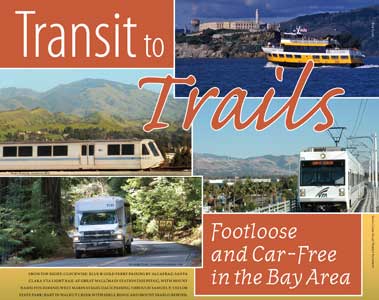- Organization Name:
- Bay Nature Institute
- Describe your creative piece – what is it and what has it been used for, and why is it innovative?
- Transit to Trails: Footloose & Car-Free in the Bay Area is a fold-out editorial supplement aimed at promoting low-carbon-footprint exploration of the Bay Area’s extensive network of public open space. Transit to Trails appeared in the April 2009 issue of Bay Nature, a nonprofit quarterly magazine. An additional 29,000 copies of Transit to Trails were printed for distribution to transit agencies, park agencies and nonprofit groups around the region. A downloadable PDF was also made available. Transit to Trails features an 17 x 22 inch fold-out map showing transit lines that access public open space and highlights 13 transit-accessible hikes around the region. It also includes three articles by local authors about their car-free excursions to Point Reyes, Mount Diablo and the Silicon Valley bayshore. The project was a collaboration with the Bay Area Open Space Council and helped spark the Council’s development of an innovative online transit-to-trails resource, transitandtrails.org.
- What issue or problem were you working to address with this piece?
- The largest source of greenhouse gas (GHG) emissions in the Bay Area is motorized transportation¬—largely cars and trucks. Knowing that, how could Bay Nature, with its audience of people who enjoy exploring nature, most effectively make a difference? Our answer: By showing our readers that there is something concrete they can do to reduce their carbon footprint. Transit to Trails does this by giving them an alternative to driving their cars to reach many of their favorite parks and beaches. Through its upbeat text and beautiful map—appealing as much to our readers’ sense of adventure as their sense of obligation—Transit to Trails offers Bay Area residents who enjoy the natural world a doable and engaging way to reduce their carbon footprint. By partnering with many local organizations and agencies, which embraced Transit to Trails as a cost-free education and outreach resource for their constituencies, Bay Nature was able to greatly expand the reach of this publication.
- How has your submission successfully impacted your organization’s ability to solve this issue/problem?
- Collaborating with other organizations for both content and distribution allowed our small non-profit to make a larger impact and reach a larger audience than we could have through our magazine circulation and website alone. Transit to Trails established our ability to produce effective and attractive materials that can enhance the public outreach programs of many local organizations involved in climate change mitigation and adaptation work. For example, copies were requested by the local Bike-To-Work Day organizers for distribution to participants in the East Bay. The continued interest in Transit to Trails will allow Bay Nature to seek funding and distribution partnerships for future publications focused on meeting the challenge of climate change.
- Creative Submission - Files
-
-
-
-


